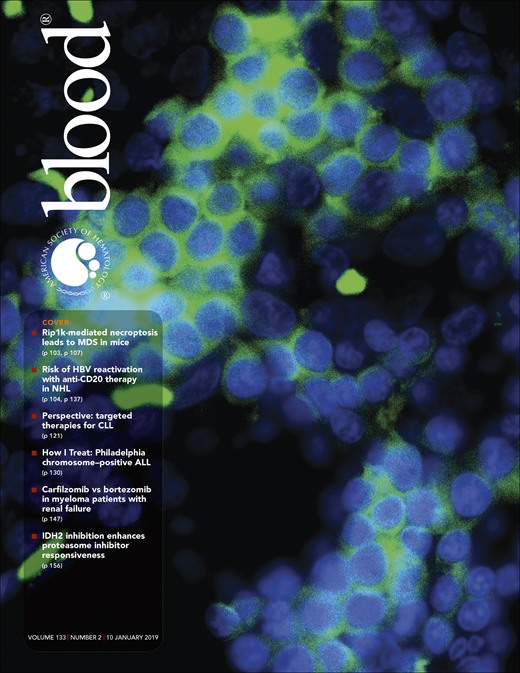A 40-year-old woman was diagnosed with acute myeloid leukemia (AML) with diploid cytogenetics. Molecular studies were positive for NPM1p.W288fs, FLT-3p.N676K, and FLT-3p.D835V mutations (variant allele frequency [VAF], 37%, 5%, and 17%, respectively). Postchemotherapy, she achieved complete remission and underwent allogeneic stem cell transplant. Unfortunately, her disease relapsed 6 months posttransplant with 45% aberrant myeloblasts (panel A, hematoxylin and eosin stain, original magnification ×20; and panel B, Wright-Giemsa stain, original magnification ×100), with immunophenotype similar to blasts at the time of diagnosis: CD34+/CD117+/CD13+/CD33+/CD123dec/HLA−DR−/MPO+ (panel C). Molecular studies were positive for NPM1p.W288fs (VAF, 10%), FLT-3p.N676K (VAF, 4%), and additional mutations in TET2p.L1231P, TET2p.K1299, and WT1p.R458* genes (VAF, 30%, 4%, and 5%, respectively). Chimerism study showed 61% XX and 39% XY. Cytogenetic study showed an abnormal karyotype: 46,XX,t(4;12)(q12;p13[19]/46,XY[1]) (panel D). Fluorescence in situ hybridization with FIP1L1/CHIC2/PDGFRA (panel E) and ETV6 break-apart (panel F) probes on metaphases revealed PDGFRA and ETV6 gene rearrangements, respectively, confirming karyotype and indicating PDGFRA-ETV6 fusion. No eosinophilia was present. FISH was negative for PDGFRA rearrangement at initial diagnosis of AML.
NPM1 mutated AML usually has a diploid karyotype. To our knowledge, this is the first case of NPM1 mutated AML that relapsed after allogeneic stem cell transplant with PDGFRA rearrangement, resulting in PDGFRA-ETV6 fusion, likely a result of a NPM1+ subclone that persisted and showed posttransplant clonal evolution.
A 40-year-old woman was diagnosed with acute myeloid leukemia (AML) with diploid cytogenetics. Molecular studies were positive for NPM1p.W288fs, FLT-3p.N676K, and FLT-3p.D835V mutations (variant allele frequency [VAF], 37%, 5%, and 17%, respectively). Postchemotherapy, she achieved complete remission and underwent allogeneic stem cell transplant. Unfortunately, her disease relapsed 6 months posttransplant with 45% aberrant myeloblasts (panel A, hematoxylin and eosin stain, original magnification ×20; and panel B, Wright-Giemsa stain, original magnification ×100), with immunophenotype similar to blasts at the time of diagnosis: CD34+/CD117+/CD13+/CD33+/CD123dec/HLA−DR−/MPO+ (panel C). Molecular studies were positive for NPM1p.W288fs (VAF, 10%), FLT-3p.N676K (VAF, 4%), and additional mutations in TET2p.L1231P, TET2p.K1299, and WT1p.R458* genes (VAF, 30%, 4%, and 5%, respectively). Chimerism study showed 61% XX and 39% XY. Cytogenetic study showed an abnormal karyotype: 46,XX,t(4;12)(q12;p13[19]/46,XY[1]) (panel D). Fluorescence in situ hybridization with FIP1L1/CHIC2/PDGFRA (panel E) and ETV6 break-apart (panel F) probes on metaphases revealed PDGFRA and ETV6 gene rearrangements, respectively, confirming karyotype and indicating PDGFRA-ETV6 fusion. No eosinophilia was present. FISH was negative for PDGFRA rearrangement at initial diagnosis of AML.
NPM1 mutated AML usually has a diploid karyotype. To our knowledge, this is the first case of NPM1 mutated AML that relapsed after allogeneic stem cell transplant with PDGFRA rearrangement, resulting in PDGFRA-ETV6 fusion, likely a result of a NPM1+ subclone that persisted and showed posttransplant clonal evolution.
For additional images, visit the ASH Image Bank, a reference and teaching tool that is continually updated with new atlas and case study images. For more information, visit http://imagebank.hematology.org.

![A 40-year-old woman was diagnosed with acute myeloid leukemia (AML) with diploid cytogenetics. Molecular studies were positive for NPM1p.W288fs, FLT-3p.N676K, and FLT-3p.D835V mutations (variant allele frequency [VAF], 37%, 5%, and 17%, respectively). Postchemotherapy, she achieved complete remission and underwent allogeneic stem cell transplant. Unfortunately, her disease relapsed 6 months posttransplant with 45% aberrant myeloblasts (panel A, hematoxylin and eosin stain, original magnification ×20; and panel B, Wright-Giemsa stain, original magnification ×100), with immunophenotype similar to blasts at the time of diagnosis: CD34+/CD117+/CD13+/CD33+/CD123dec/HLA−DR−/MPO+ (panel C). Molecular studies were positive for NPM1p.W288fs (VAF, 10%), FLT-3p.N676K (VAF, 4%), and additional mutations in TET2p.L1231P, TET2p.K1299, and WT1p.R458* genes (VAF, 30%, 4%, and 5%, respectively). Chimerism study showed 61% XX and 39% XY. Cytogenetic study showed an abnormal karyotype: 46,XX,t(4;12)(q12;p13[19]/46,XY[1]) (panel D). Fluorescence in situ hybridization with FIP1L1/CHIC2/PDGFRA (panel E) and ETV6 break-apart (panel F) probes on metaphases revealed PDGFRA and ETV6 gene rearrangements, respectively, confirming karyotype and indicating PDGFRA-ETV6 fusion. No eosinophilia was present. FISH was negative for PDGFRA rearrangement at initial diagnosis of AML. / NPM1 mutated AML usually has a diploid karyotype. To our knowledge, this is the first case of NPM1 mutated AML that relapsed after allogeneic stem cell transplant with PDGFRA rearrangement, resulting in PDGFRA-ETV6 fusion, likely a result of a NPM1+ subclone that persisted and showed posttransplant clonal evolution.](https://ash.silverchair-cdn.com/ash/content_public/journal/blood/133/2/10.1182_blood-2018-09-876946/6/m_blood876946f1.png?Expires=1763914979&Signature=mlb38yK7v6ZuXfz0pG6n7aJqPHBG-mWNY8YYWysoD78p4pxFO-I1td5RwoYlXsgOXxEsTsh7-ME1KfB8Ar5BKYydbr998oTkPApzpSQBsu3JilSZveMJq02igy-KMqW5gRgBMqhAtLEV~geRPJUuu1F7IXwPP8lTi~9KSTYzJeleXH5Grk9Ng7118MV8cpLmT-svX3tVYCG85W8NrPEy7sydbSKFJmphI9rwggLJIy6MC1jtSZ8qmcv1z4Yqy6JT2armrrT2IkBc~u5CxvqZxMKH9Crd7OpGz88BQWL0KYJpsQ72RffYRE~JkA0yiIlijxuYu~vbqH9xfpU7MP9Jqg__&Key-Pair-Id=APKAIE5G5CRDK6RD3PGA)
